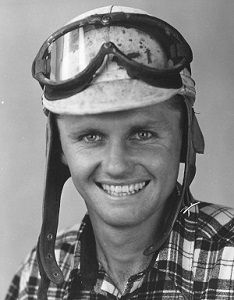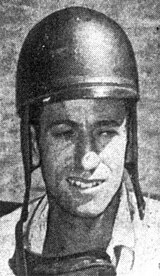
The 36th International 500-Mile Sweepstakes was a motor race held at the Indianapolis Motor Speedway on Friday, May 30, 1952. It was the opening race of the 1952 AAA National Championship Trail and was also race 2 of 8 in the 1952 World Championship of Drivers.

The 37th International 500-Mile Sweepstakes was held at the Indianapolis Motor Speedway on Saturday, May 30, 1953. The event was part of the 1953 AAA National Championship, and was race 2 of 9 in the 1953 World Championship of Drivers. Bill Vukovich, after falling just short a year before, dominated the race, leading 195 of the 200 laps. Vukovich won the first of two consecutive "500" victories, finishing more than three minutes ahead of second place Art Cross.

The 38th International 500-Mile Sweepstakes was held at the Indianapolis Motor Speedway on Monday, May 31, 1954. The event was part of the 1954 AAA National Championship Trail, and was also race 2 of 9 in the 1954 World Championship of Drivers.

The 39th International 500-Mile Sweepstakes was held at the Indianapolis Motor Speedway on Monday, May 30, 1955. The event was race 1 of 11 of the 1955 AAA National Championship Trail and was race 3 of 7 in the 1955 World Championship of Drivers.
John Ashley Thomson was an American racecar driver. Thomson was nicknamed "the Flying Scot." He won several championships in midgets and sprint cars before competing in Championship Car racing. He won the pole position for the 1959 Indianapolis 500.
Don Freeland was an American racecar driver who is best known for competing in the Indianapolis 500 eight times.
Alvah August “Al” Keller was an American racecar driver.

William John "Bill" Vukovich was an American racing driver. He won the 1953 and 1954 Indianapolis 500, plus two more American Automobile Association National Championship races, and died while leading the 1955 Indianapolis 500.

Robert Charles "Bob" Sweikert was an American racing driver, best known as the winner of the 1955 Indianapolis 500 and the 1955 National Championship, as well as the 1955 Midwest Sprint car championship – the only driver in history to sweep all three during a single racing season.

Robert Kay Ball was an American racecar driver.
Gerald Frederick Hoyt was an American racing driver from Chicago, mainly competing in the National Championship. He died on July 11, 1955, after crashing in a sprint car race at Oklahoma City.
Travis Leon "Spider" Webb was an American racing driver. He was the 1948 American Automobile Association (AAA) Midwest Sprint Car champion. He raced in numerous AAA Championship Car races including six Indianapolis 500s.
This article discusses the year-by-year history of the Indianapolis 500 race.
The Oakland Speedway was a motor racing track in San Leandro, California, a suburb of Oakland, California. It was a one-mile, banked dirt oval track built in 1931, which operated throughout the Great Depression and postwar years. The track featured AAA National Championship races with Indy cars and drivers from 1931 until 1936, when the AAA pulled out of the West Coast. Thereafter the track still featured racing by members of the Bay Cities Racing Association, in roadsters and motorcycles, as well as Big Cars, stock cars, and midgets. It was known as the "fastest dirt track in the Nation".
The 1956 USAC Championship Car season consisted of 12 races, beginning in Speedway, Indiana, on May 30 and concluding in Phoenix, Arizona, on November 12. There were also three non-championship events. The USAC National Champion was Jimmy Bryan and the Indianapolis 500 winner was Pat Flaherty. Pat was unable to race after the Springfield race as he was severely injured in a crash during the race which essentiallyended his full time racing career. This was the first year that the National Championship was sanctioned by the USAC, after the withdrawal of the AAA from all forms of racing after the 1955 season.
The 1955 AAA Championship Car season consisted of 11 races, beginning in Speedway, Indiana on May 30 and concluding in Phoenix, Arizona on November 6. There was also one non-championship event in Mechanicsburg, Pennsylvania. The AAA National Champion and Indianapolis 500 winner was Bob Sweikert. Manny Ayulo was killed at Indianapolis while practicing for the 1955 Indianapolis 500, and Bill Vukovich, the two-time defending winner, was killed in the race itself. Jack McGrath, the two-time champion, was killed in the final race at Phoenix on lap 85. This was the last year of the AAA National Championship; USAC sanctioned the series starting the next year.
The 1954 AAA Championship Car season consisted of 13 races, beginning in Speedway, Indiana on May 30 and concluding in Las Vegas, Nevada on November 14. There was also one non-championship event in Mechanicsburg, Pennsylvania. The AAA National Champion was Jimmy Bryan, and the Indianapolis 500 winner was Bill Vukovich. Bob Scott was killed in the Independence Day Sweepstakes race at Darlington.
The 1953 AAA Championship Car season consisted of 12 races, beginning in Speedway, Indiana on May 30 and concluding in Phoenix, Arizona on November 11. There was also one non-championship event in Mechanicsburg, Pennsylvania. The AAA National Champion was Sam Hanks, and the Indianapolis 500 winner was Bill Vukovich. Chet Miller died while practicing for the Indianapolis 500.
The 1952 AAA Championship Car season consisted of 12 races, beginning in Speedway, Indiana on May 30 and concluding in Phoenix, Arizona on November 11. There was also one non-championship event in Mechanicsburg, Pennsylvania. The AAA National Champion was Chuck Stevenson, and the Indianapolis 500 winner was Troy Ruttman. Johnny McDowell was killed at the Milwaukee while qualifying for the Rex Mays Classic. Joe James died in the San José 100 race.

The Circle K/Fiesta Bowl 200 was the final name of a PPG IndyCar World Series race held annually at Phoenix International Raceway in Avondale, Arizona, from 1979 though 1986; it was known as the Miller High Life 150 for five editions during that period. The race was known by multiple other names, operated under other sanctioning bodies, and was run at other distances during a much longer history before IndyCar.







